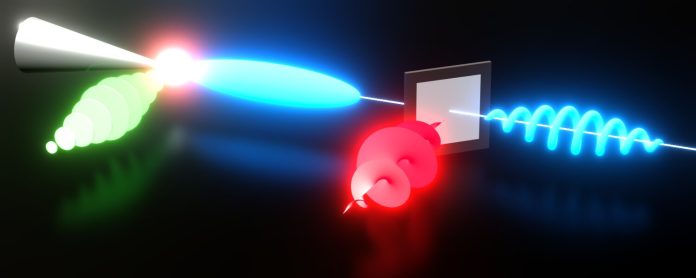
Have you ever tried putting your left hand on the back of your right hand, aligning all fingers in the same direction?
You’ll notice your thumbs don’t match up. This difference is called chirality—where something can’t be superimposed on its mirror image.
Scientists have now discovered a way to imprint this chirality onto electrons, giving them a previously unseen three-dimensional shape.
Researchers at the University of Konstanz have achieved this by using laser light to mold an electron’s wave into left-handed or right-handed coils of mass and charge.
This breakthrough could have significant implications for fundamental physics and various applications like quantum optics, particle physics, and electron microscopy.
“We are opening up new potentials for scientific research that have not been considered before,” says Peter Baum, lead author of the study published in Science and head of the Light and Matter research group at the University of Konstanz.
Chiral objects are crucial in nature and technology. For elementary particles, spin is a common chiral phenomenon.
Spin, a purely quantum-mechanical property, gives rise to many significant phenomena, including magnetism and the structure of the periodic table. It’s also essential for developing advanced technologies like quantum computers and superconductors.
Some chiral objects, like our hands, are made of non-chiral components. Despite this, they exhibit chirality due to their overall structure. In molecules, chirality can mean the difference between a healing drug and a harmful substance because of their different three-dimensional shapes.
In materials science, chirality affects the behavior of magnetic materials and metamaterials, leading to phenomena like topological insulators or chiral dichroism. Controlling the chirality of composite materials made of non-chiral components offers new ways to fine-tune material properties for various applications.
Is it possible to shape a single electron into a chiral three-dimensional object in terms of charge and mass? The Konstanz researchers have shown that it is. They used an ultrafast transmission electron microscope combined with laser technology to achieve this.
First, they generated ultrafast electron pulses and then shaped them into chiral patterns using laser waves with spiral electric fields. Normally, electrons and laser photons don’t interact in such experiments because energy and momentum can’t be conserved. However, by using silicon nitride membranes that alter the phase of the laser light, the researchers facilitated the interaction.
The laser’s spiral electric fields accelerated or decelerated the electrons around the beam’s center, depending on their position. Eventually, the accelerated and decelerated electrons caught up with each other, transforming their wave function into a chiral coil of mass and charge.
Using attosecond electron microscopy, the team measured the electron’s expectation value, revealing right- or left-handed single or double coils. This purely geometrical chirality was achieved without needing spin, angular momentum, or spiral trajectories.
The ability to shape electrons into chiral coils opens new avenues for scientific exploration and technological innovation. These engineered chiral electron beams could be useful for chiral electron-optical tweezers, chiral sensors, quantum electron microscopy, or probing rotational motion in atomic or nanostructured materials. They will also contribute to particle physics and quantum optics.
“Although we have so far only modulated the electron, one of the simplest elementary particles, the method is general and applicable to almost any particle or matter wave. What other elementary particles have or can have such chiral shapes, and are there possible cosmological consequences?” says Baum.
The researchers’ next step is to use their chiral electrons in attosecond electron imaging and two-electron microscopy to further explore the interplay between chiral light and chiral matter waves, paving the way for future technological applications.



